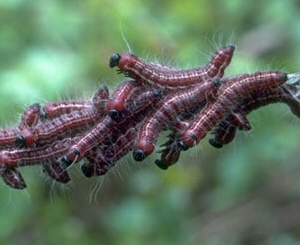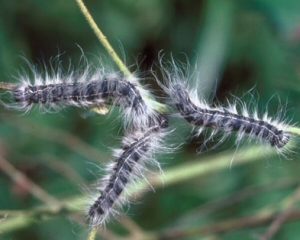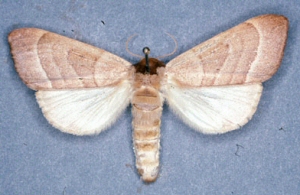Walnut Caterpillar
 Scientific Name
Scientific Name
Datana Integerrima
Hosts
The larvae feed only on foliage of trees of the family Juglandaceae. Hosts include
black and English walnuts, butternut, pecan, and various species of hickory.
Damage: These large caterpillars can defoliate the trees and severely affect tree
vigor, yield, and nut quality. The earlier the tree is defoliated, the more harmful
the damage to the tree. Trees can withstand 2 or 3 consecutive years of heavy defoliation
before they die. Epidemics seldom last longer than 2 years in any one location.
 Life Cycle
Life Cycle
There are two generations of this pest per year in Oklahoma. Moths emerge from mid-May to early June and in late July and early August. Larvae feed on the leaves in June and July and from late August into October. The larvae are gregarious and feed in groups, but do not spin webs in which to feed. Small larvae skeletonize the leaves but larger larvae consume all but the petiole. They migrate back to the trunk or larger limbs in groups each time they are ready to shed their skins. Mature larvae leave the trees and pupate in the soil. Pupae of the second generation overwinter.
 Description
Description
Walnut caterpillar moths are light brown with four narrow, brown bands on each front wing and a dark red brown thorax. The wingspan is about 1 3/4 inches. The larvae are dark red when young but become black near maturity. They have many long, white hairs on the body. When disturbed, they usually raise the front and back thirds of the body. Mature larvae are about 2 inches long. The eggs are round and white and are laid in loose masses on the undersides of leaves. This species is often called the walnut datana.
Control
Walnut caterpillars are attacked by many species of parasites and predators and several diseases. These beneficial organisms often keep numbers low or cause the collapse of outbreaks. The bacterial insecticide, Bacillus thuringiensis, is quite effective as a control agent. It is also possible to remove and destroy masses of larvae when they are small. Please contact your local county extension office for current information.



